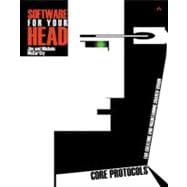
Jim and Michele McCarthy founded McCarthy Technologies in 1996, after product development and program management positions at Microsoft, the Whitewater Group, Bell Laboratories, and elsewhere. Jim is the author of Dynamics of Software Development (Microsoft Press, 1995).
Jim and Michele McCarthy founded McCarthy Technologies in 1996, after product development and program management positions at Microsoft, the Whitewater Group, Bell Laboratories, and elsewhere. Jim is the author of Dynamics of Software Development (Microsoft Press, 1995).
| Acknowledgments | xi | ||||
| Introduction | xiii | ||||
| PART I CHECK IN | 1 | (104) | |||
|
11 | (8) | |||
|
11 | (1) | |||
|
12 | (1) | |||
|
13 | (1) | |||
|
13 | (1) | |||
|
14 | (1) | |||
|
14 | (1) | |||
|
15 | (4) | |||
|
19 | (34) | |||
|
19 | (13) | |||
|
32 | (11) | |||
|
43 | (3) | |||
|
46 | (2) | |||
|
48 | (5) | |||
|
53 | (16) | |||
|
53 | (10) | |||
|
63 | (3) | |||
|
66 | (3) | |||
|
69 | (36) | |||
|
69 | (5) | |||
|
74 | (3) | |||
|
77 | (3) | |||
|
80 | (2) | |||
|
82 | (23) | |||
| PART II DECIDER | 105 | (74) | |||
|
111 | (6) | |||
|
114 | (1) | |||
|
115 | (2) | |||
|
117 | (32) | |||
|
117 | (13) | |||
|
130 | (7) | |||
|
137 | (3) | |||
|
140 | (6) | |||
|
146 | (3) | |||
|
149 | (30) | |||
|
149 | (5) | |||
|
154 | (4) | |||
|
158 | (5) | |||
|
163 | (2) | |||
|
165 | (14) | |||
| PART III ALIGNING | 179 | (82) | |||
|
185 | (4) | |||
|
185 | (4) | |||
|
189 | (10) | |||
|
189 | (10) | |||
|
199 | (16) | |||
|
199 | (9) | |||
|
208 | (7) | |||
|
215 | (46) | |||
|
215 | (17) | |||
|
232 | (4) | |||
|
236 | (5) | |||
|
241 | (6) | |||
|
247 | (6) | |||
|
253 | (8) | |||
| PART IV SHARED VISION | 261 | (72) | |||
|
269 | (10) | |||
|
271 | (5) | |||
|
276 | (3) | |||
|
279 | (24) | |||
|
279 | (8) | |||
|
287 | (3) | |||
|
290 | (12) | |||
|
302 | (1) | |||
|
303 | (22) | |||
|
303 | (2) | |||
|
305 | (8) | |||
|
313 | (4) | |||
|
317 | (8) | |||
|
325 | (8) | |||
|
325 | (8) | |||
| PART V APPENDIXES | 333 | (92) | |||
|
335 | (18) | |||
|
353 | (30) | |||
|
383 | (42) | |||
| Index | 425 | (8) | |||
| Artwork | 433 | (2) | |||
| Authors | 435 |
The New copy of this book will include any supplemental materials advertised. Please check the title of the book to determine if it should include any access cards, study guides, lab manuals, CDs, etc.
The Used, Rental and eBook copies of this book are not guaranteed to include any supplemental materials. Typically, only the book itself is included. This is true even if the title states it includes any access cards, study guides, lab manuals, CDs, etc.